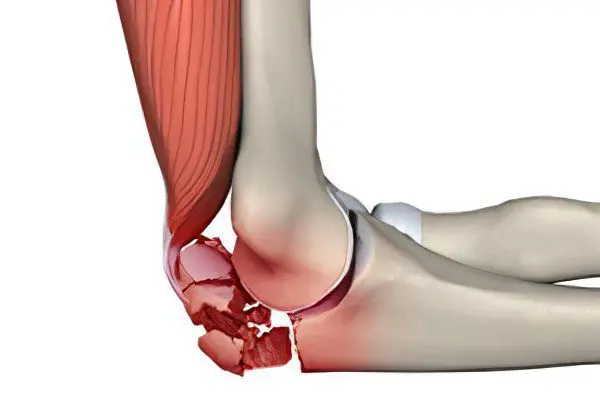Contents

The elbow joint has a complex structure: it is formed by the humerus, ulna and radius bones, while inside the main, large joint there are three more small ones. Movements in the elbow joint are carried out only in two planes, however, they have a rather complex mechanism.
Large vessels and nerves pass through this joint, which are responsible for the blood supply and innervation of the forearms and hands. Therefore, a fracture of the elbow joint, accompanied by damage to blood vessels and nerves, often leads to the development of serious complications. Most often, surgery is performed to properly heal the bones.
At the same time, the elbow joint is the most stable in the human body, which provides great opportunities for compensation in case of such an injury. Elbow fractures account for an average of 20% of all intra-articular fractures.
Possible causes of fracture
The cause of the fracture can be a fall on the elbow or a straightened arm, a direct blow to the olecranon, a previous dislocation of the joint, or an injury to the forearm. The likelihood of a fracture increases with weakness of the elbow ligaments and tendons.
Types of fractures of the elbow joint
The olecranon of the ulna is a typical localization of damage to the elbow: it is not protected by the muscular frame and always takes the first blow. However, fractures of the olecranon are quite rare, in 0,8-1,5% of cases.
Other types of fractures include:
Heads and necks of the radius (occurs when falling with emphasis on a straight arm);
Coronoid process of the ulna (occurs rarely, but is usually combined with dislocation, displacement, trauma of the forearm);
The epicondyle of the humerus.
Also, fractures are divided into intraarticular and periarticular, closed and open, with and without displacement of the bones. In 53% of cases, any one bone is damaged during a fracture. In closed fractures, which are more common, the bones do not damage the soft tissues. With open fractures, the integrity of the skin is violated, an open wound appears and the bone tissue comes out.
Symptoms of an elbow fracture

Sharp pain in the elbow and forearm, which can spread to the wrist and fingers;
Significant limitation of mobility in the joint or complete immobility;
As an opposite phenomenon – pathological, unusual mobility in any one direction, for example, lateral;
Edema and the formation of a pronounced hematoma due to hemorrhage in the joint cavity;
Perhaps the appearance of neurological symptoms – tingling and numbness in the forearm, hand and fingers, as there is damage to the nerve fibers;
Damage to muscles, blood vessels, nerves, skin in case of an open fracture.
When the olecranon is fractured, pain occurs in the back of the joint, which can radiate to the forearm and shoulder. Edema and hematoma spread to the anterior surface of the joint. The function of arm extension is impaired, since the triceps is attached to the olecranon, which is responsible for extending the forearm. The injured arm dangles limply. Stiffness of the forearm during the production of rotational movements is manifested to a lesser extent.
In case of damage to the neck of the radius pain appears in the anterior part of the joint and may also radiate to the forearm. Edema and hematoma are mild. A characteristic feature of this type of fracture is a severe limitation of rotation of the forearm.
With a fracture of the coronoid process appears pain on the front side of the joint, which increases with palpation. Functions of flexion and extension of the joint are limited. There is a slight swelling above the joint, no deformities.
In a displaced fracture, passive extension is possible, while active extension causes severe pain.
Diagnosis and treatment

First aid
Treatment tactics are selected depending on the specifics of the fracture and the degree of damage. But in any case, the primary task is the complete immobilization (ensuring immobility) of the joint, which consists in the imposition of a splint. In this case, the arm is bent at an angle of 90 ° C, brought with the palm to the body and fixed in this position.
The hand, wrist and shoulder joints are also immobilized. Pain is relieved with analgesics.
Diagnostics
On palpation of the elbow along the fracture line, there is a sharp pain. To make an accurate diagnosis, an x-ray is performed, which is done in two projections, direct and lateral. Since an elbow fracture is often accompanied by an annular ligament tear, an X-ray of the condyles of the humerus and the upper third of the bones of the forearm is also taken.
X-ray examination will clarify the location and type of fracture, on the basis of which the treatment tactics will be determined. In some cases, CT and MRI methods are additionally used (with an intra-articular fracture).
In a displaced fracture, passive extension at the elbow is preserved, but with active extension, the pain increases sharply. With a fracture without displacement, there is predominantly limited movement in the joint.
Treatment
With a slight displacement of the bones, up to 5 mm, the joint is reduced. In other cases, with more pronounced displacements, a surgical operation is required, during which the affected area is opened, the correct position of all bones is restored and osteosynthesis methods are applied (parts of the bones are fastened with special fixators, plates and knitting needles). If necessary, the damaged head of the radius is removed and replaced with an endoprosthesis. Then a plaster splint is applied to the damaged area.
Before surgery, a course of drug treatment is prescribed to reduce swelling and hematoma. Venous outflow improves with an elevated position of the elbow joint. With an open fracture, surgery should be performed within a day after the injury.
With a fracture of the neck of the radius without displacement plaster is worn for two to three weeks, with a fracture of the coronoid process – for three to four weeks. A plaster bandage is applied to the entire area from the fingers to the humerus, the elbow joint is fixed in a bent position.
After 4 weeks, the plaster splint is periodically removed for 15-20 minutes a day to develop the joint. The total duration of treatment, including the rehabilitation period, is one and a half to two months.
In case of a displaced fracture, a cast is applied after the operation for a period of 4-6 weeks. The total duration of treatment, including the rehabilitation period, is 2-3 months. The pins are removed a few months after the injury.
Rehabilitation period

Rehabilitation therapy includes:
Therapeutic physical education (LFK);
Massage;
Physiotherapy.
The development of the elbow joint through physical exercises plays a very important role in the process of its recovery. Neglect of exercise therapy can lead to partial or even complete loss of mobility in the joint.
At the first stage, which begins on the second day after the cast is applied, exercises are performed for the joints free of plaster – the wrist and shoulder, as well as for the fingers, since the muscles responsible for the movement of the fingers come from the elbow joint. It is also recommended to periodically put your hand behind your head while lying down (for example, put it behind your head on a pillow), while straining the muscles of the shoulder and forearm. This stimulates lymphatic drainage and helps relieve swelling. Isotonic contractions of the muscles (tension without movement) under the cast should be started 7-10 days after the fracture. To reduce pain, you can combine these exercises with breathing techniques.
At the second stage, exercises are performed to flex and extend the elbow joint itself. To do this, part of the plaster splint is temporarily removed from the forearm. The transition to the second stage of rehabilitation is carried out at the discretion of the attending physician. In case of a fracture of the olecranon, it is impossible to bend the arm at the joint, as this can provoke a second fracture.
These exercises can be done as follows:
Sit at the table, put your hand on the table, and from this position raise and lower your forearm;
Clasp the hands in the lock and bend-unbend both the injured and the healthy arm, lifting them behind the head.
You can do exercises sitting or standing, using a gymnastic stick or ball, as well as in water, in a pool or taking a bath. For these purposes, a bath with sea salt is well suited, since salt perfectly stimulates the restoration of lost functions and relieves pain.
The full development of the joint is transferred after the final removal of the gypsum. You should start with slow bending in a gentle mode, while the shoulder lies on a horizontal surface (on the table), and the forearm is located vertically.
Complex of exercises

Clasp the hands together and make movements that imitate the casting of a fishing rod, alternately winding the hands linked into the “lock” behind the ears from different sides;
A similar exercise, but bring the hands behind the head;
Connect the hands behind the back;
Put your hands behind your head, clasp your hands in the lock and stretch, pointing your palms up;
Roll a toy car on the table;
Pick up a gymnastic stick and do flexion-extension in the elbows, holding the stick in front of you and above your head;
Bend the elbow joint at a right angle and rotate the forearm around its axis;
Roll the balls with the fingers of the injured hand.
All exercises should be done 3-4 times a day for 10-15 repetitions, starting with 4-6 and gradually increasing the load. Exercises must be performed with a healthy hand, since the elbow joint is a paired organ, they are interconnected. The elbow joint is the most difficult to develop. Therefore, sometimes the use of special equipment is required to eliminate persistent disorders of articular movements.
Physical exercises are recommended to be combined with physiotherapy. For this, magnetic therapy is prescribed, electrophoresis, UHF, mud therapy can also be used.
Massage at the first stage of rehabilitation is contraindicated. At the 2nd and 3rd stages, you can massage the back and arm muscles above and below the damaged area (muscles of the forearm and shoulder). Gentle massage helps to restore motor functions, reduces pain, prevents muscle atrophy, strengthens ligaments.
In case of a fracture of the elbow joint, it is strictly forbidden to carry weights and hang on the crossbar, to overwork the muscles.
Intra-articular fractures are fraught with the development of persistent contracture (limitation of range of motion) or arthrosis in the distant future. That is why it is necessary to take seriously the complex of rehabilitation measures to restore the affected joint and follow all the instructions of the attending physician.
Nutrition after a fracture
To help the body recover as quickly as possible after an injury, you should pay attention to your diet. To strengthen the ligaments, collagen is of great importance, as well as vitamins C and E.
Collagen is found in poultry meat (especially turkey), fish (especially salmon species), oysters, mussels, shrimp, seaweed and other seafood, buckwheat, oatmeal, persimmons, peaches. Vitamin C is rich in white and cauliflower, tomatoes, bell peppers, currants, rose hips, mountain ash, citrus fruits, strawberries, greens (parsley, spinach), green peas. Vitamin E is found in grains of cereals, carrots, sea buckthorn, soy, garlic, parsley, pumpkin and flax seeds, egg yolk, yeast, peanut butter, nuts.
If you are overweight, a diet is recommended. Excess weight puts additional stress on the joints, which leads to disruption of metabolic processes in them.









